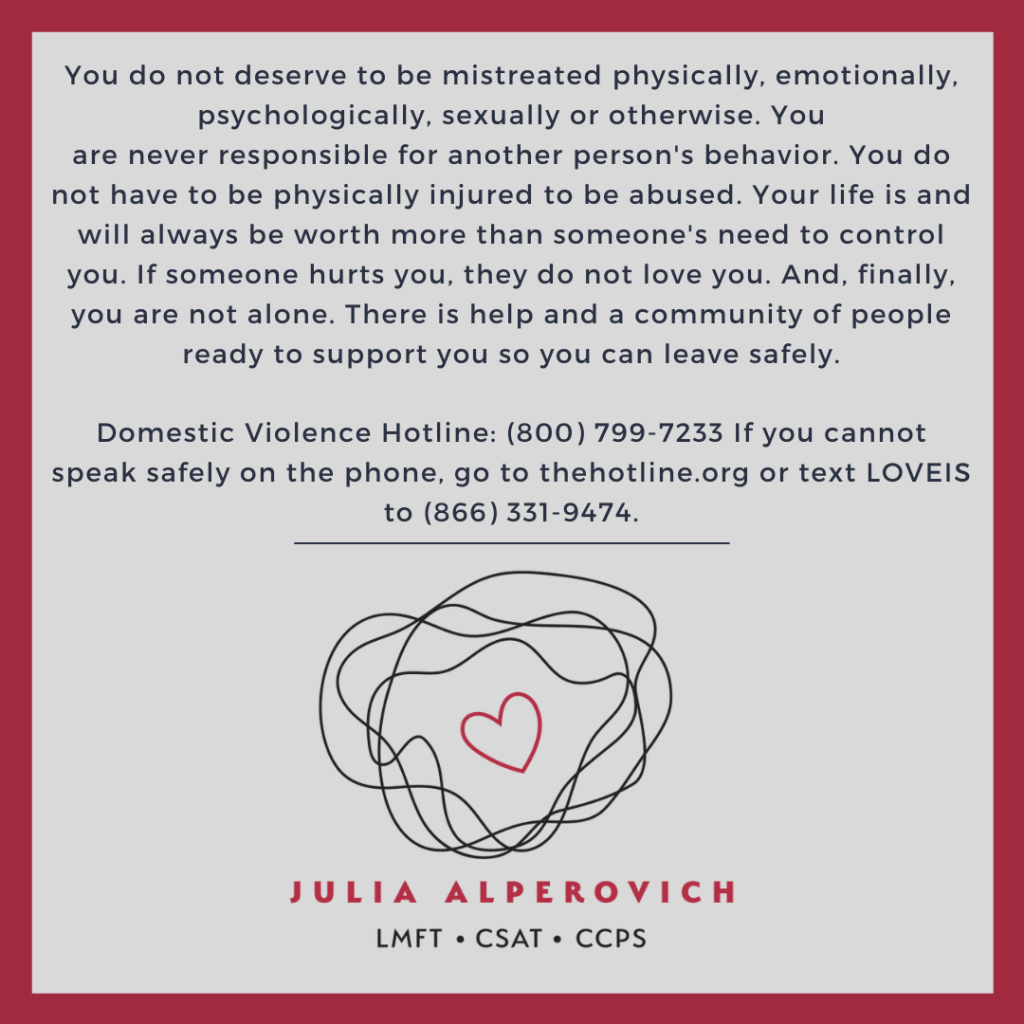If you are in an abusive relationship, here are Abuse Resources for help. I was in an abusive relationship. You can read about this here.
As you will find from the statistics below and from my story, you are not alone. I accept new patients here.
P. O. Box 1798
Sacramento, CA 95812
Office: (916) 444-7163 Fax: (916) 444-7165
Website: www.cpedv.org
Email: [email protected]
Here are some alarming statistics from the National Domestic Violence Hotline
| On average, 24 people per minute are victims of rape, physical violence or stalking by an intimate partner in the United States — more than 12 million women and men over the course of a year.[i] |
| Nearly 3 in 10 women (29%) and 1 in 10 men (10%) in the US have experienced rape, physical violence and/or stalking by a partner and report a related impact on their< functioning.[ii] |
| Nearly, 15% of women (14.8%) and 4% of men have been injured as a result of IPV that included rape, physical violence and/or stalking by an intimate partner in their lifetime.[iii] |
| 1 in 4 women (24.3%) and 1 in 7 men (13.8%) aged 18 and older in the United States have been the victim of severe physical violence by an intimate partner in their lifetime.[iv] |
| IPV alone affects more than 12 million people each year.[v] |
| More than 1 in 3 women (35.6%) and more than 1 in 4 men (28.5%) in the United States have experienced rape, physical violence and/or stalking by an intimate partner in their lifetime.[vi] |
| Nearly half of all women and men in the United States have experienced psychological aggression by an intimate partner in their lifetime (48.4% and 48.8%, respectively).[vii] |
| Females ages 18 to 24 and 25 to 34 generally experienced the highest rates of intimate partner violence.[viii] |
| From 1994 to 2010, about 4 in 5 victims of intimate partner violence were female.[ix] |
| Most female victims of intimate partner violence were previously victimized by the same offender, including 77% of females ages 18 to 24, 76% of females ages 25 to 34, and 81% of females ages 35 to 49.[x] |
SEXUAL VIOLENCE
| Nearly 1 in 5 women (18.3%) and 1 in 71 men (1.4%) have been raped in their lifetime (by any perpetrator).[i] |
| Nearly 1 in 10 women in the United States (9.4%) have been raped by an intimate partner in her lifetime.[ii] |
| 81% of women who experienced rape, stalking, or physical violence by an intimate partner reported significant short- or long-term impacts such as post-traumatic stress disorder symptoms and injury.[iii] |
| 35% of men report such impacts of their experiences.[iv] |
| More than half (51.1%) of female victims of rape reported being raped by an intimate partner and 40.8% by an acquaintance.[v] |
| For male victims, more than half (52.4%) reported being raped by an acquaintance, and 15.1% by a stranger.[vi] |
| An estimated 13% of women and 6% of men have experienced sexual coercion in their lifetime (i.e. unwanted sexual penetration after being pressured in a nonphysical way). 27.2% of women and 11.7% of men have experienced unwanted sexual contact (by any perpetrator).[vii] |
STALKING
| One in 6 women (16.2%) and 1 in 19 men (5.2%) in the United States have experienced stalking victimization at some point during their lifetime in which they felt very fearful or believed that they or someone close to them would be harmed or killed (by any perpetrator).[i] |
| Two-thirds (66.2%) of female victims of stalking were stalked by a current or former intimate partner.[ii] |
| Men were primarily stalked by an intimate partner or acquaintance (41.4% and 40%, respectively).[iii] |
| Repeatedly receiving unwanted telephone calls, voice, or text messages was the most commonly experienced stalking tactic for both female and male victims of stalking (78.8% for women and 75.9% for men).[iv] |
| An estimated 10.7% of women and 2.1% of men have been stalked by an intimate partner during their lifetime.[v] |
CHILDREN
| A child witnessed violence in 22% (nearly 1 in 4) of intimate partner violence cases filed in state courts. [i] |
| 30 to 60% of perpetrators of intimate partner violence also abuse children in the household. [ii] |
| There is a common link between domestic violence and child abuse. Among victims of child abuse, 40% report domestic violence in the home (from a WORLD REPORT).[iii] |
| One study in North America found that children who were exposed to violence in the home were 15 times more likely to be physically and/or sexually assaulted than the national average.[iv] |
| The U.S. Advisory Board on Child Abuse and Neglect suggests that domestic violence may be the single major precursor to child abuse and neglect fatalities in this country.[v] |
[i] http://www.ojp.usdoj.gov/newsroom/pressreleases/2009/BJS10007.htm
[ii] https://www.ncjrs.gov/pdffiles1/nij/grants/213503.pdf
[iii-v] http://www.unicef.org/protection/files/BehindClosedDoors.pdf
TEENS
| In a nationwide survey, 9.4% of high school students report being hit, slapped, or physically hurt on purpose by their boyfriend or girlfriend in the 12 months prior to the survey.[i] |
| About 1 in 5 women and nearly 1 in 7 men who ever experienced rape, physical violence, and/or stalking by an intimate partner, first experienced some form of partner violence between 11 and 17 years of age.[ii] |
| More than a quarter of male victims of completed rape (28%) were first raped when they were 10 years old or younger (by any perpetrator).[iii] |
| About 35% of women who were raped as minors also were raped as adults compared to 14% of women without an early rape history.[iv] |
| Most female victims of completed rape (79.6%) experienced their first rape before the age of 25; 42.2% experienced their first completed rape before the age of 18 years.[v] |
| One in 10 high school students has experienced physical violence from a dating partner in the past year.[vi] |
| Most female and male victims of rape, physical violence, and/or stalking by an intimate partner (69% of female victims, 53% of male victims) experienced some form of intimate partner violence for the first time before 25 years of age.[vii] |
| 43% of dating college women report experiencing violent and abusive dating behaviors including physical, sexual, tech, verbal or controlling abuse.[viii] |
| Nearly 1 in 3 (29%) college women say they have been in an abusive dating relationship.[ix] |
| 52% of college women report knowing a friend who has experienced violent and abusive dating behaviors including physical, sexual, tech, verbal or controlling abuse.[x] |
| More than half (57%) of college students who report experiencing dating violence and abuse said it occurred in college.[xi] |
| 58% of college students say they don’t know what to do to help someone who is a victim of dating abuse.[xii] |
| 38% of college students say they don’t know how to get help for themselves if they were a victim of dating abuse.[xiii] |
| More than half of all college students (57%) say it is difficult to identify dating abuse.[xiv] |
| 1 in 3 (36%) dating college students has given a dating partner their computer, email, or social network passwords and these students are more likely to experience digital dating abuse.[xv] |
| 1 in 5 college women has been verbally abused by a dating partner.[xvi] |
| 1 in 6 (16%) college women has been sexually abused in a dating relationship.[xvii] |
| 1 in 4 dating teens is abused or harassed online or through texts by their partners.[xviii] |
| Victims of digital abuse and harassment are 2 times as likely to be physically abused, 2.5 times as likely to be psychologically abused, and 5 times as likely to be sexually coerced.[xix] |
| Nearly 1 in 10 teens in relationships report to having a partner tamper with their social networking account (the most frequent form of harassment or abuse).[xx] |
| Only 1 in 5 victims say they experienced digital abuse or harassment at school and during school hours (most takes place away from school grounds).[xxi] |
| About 84% of victims are psychologically abused by their partners, half are physically abused, and one-third experiences sexual coercion.[xxii] |
| Only 4% experience digital abuse and harassment alone. So social media, texts, and e-mails don’t seem to invite new abuse, they just provide abusive partners with a new tool.[xxiii] |
[i] http://www.cdc.gov/violenceprevention/intimatepartnerviolence/teen_dating_violence.html
[ii] [vi] http://www.cdc.gov/violenceprevention/pdf/datingmatters_flyer_2012-a.pdf
[iii-vii] http://www.cdc.gov/violenceprevention/pdf/cdc_nisvs_overview_insert_final-a.pdf
[viii-xvii] https://www.loveisrespect.org/pdf/College_Dating_And_Abuse_Final_Study.pdf
[xviii-xxiii] http://www.urban.org/UploadedPDF/412750-teen-dating-abuse.pdf
IN THE WORKPLACE
| Nearly 33% of women killed in U.S. workplaces between 2003-2008 were killed by a current or former intimate partner.[i] |
| Nearly one in four large private industry establishments reported at least one incidence of domestic violence, including threats and assaults, in 2005.[ii] |
| A survey of American employees found that 44% of full-time employed adults personally experienced domestic violence’s effect in their workplaces, and 21% identified themselves as victims of intimate partner violence.[iii] |
| 64% of the respondents in a 2005 survey who identified themselves as victims of domestic violence indicated that their ability to work was affected by the violence. More than half of domestic violence victims (57%) said they were distracted, almost half (45%) feared getting discovered, and two in five were afraid of their intimate partner’s unexpected visit (either by phone or in person).[iv] |
| Nearly two in three corporate executives (63%) say that domestic violence is a major problem in our society and more than half (55%) cite its harmful impact on productivity in their companies.[v] |
| Nine in ten employees (91%) say that domestic violence has a negative impact on their company’s bottom line. Just 43% of corporate executives agree. Seven in ten corporate executives (71%) do not perceive domestic violence as a major issue at their company.[vi] |
| More than 70% of United States workplaces do not have a formal program or policy that addresses workplace violence.[vii] |
| Nearly 8 million days of paid work each year is lost due to domestic violence issues – the equivalent of more than 32,000 full-time jobs.[viii] |
| 96% of domestic violence victims who are employed experience problems at work due to abuse.[ix] |
[i] http://www.annalsofepidemiology.org/article/S1047-2797(12)00024-5/abstract
[ii] [vii] http://www.bls.gov/iif/oshwc/osnr0026.pdf
[iii-iv] http://www.caepv.org/getinfo/facts_stats.php?factsec=3
[v-vi] http://www.caepv.org/about/program_detail.php?refID=34
[viii] http://www.cdc.gov/ncipc/pub-res/ipv_cost/IPVBook-Final-Feb18.pdf
[ix] http://www.clicktoempower.org/domestic-violence-facts.aspx


